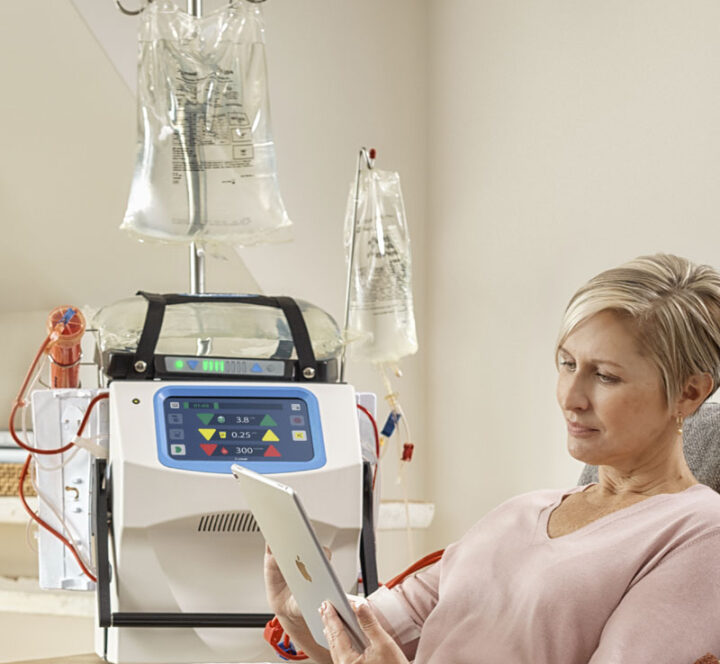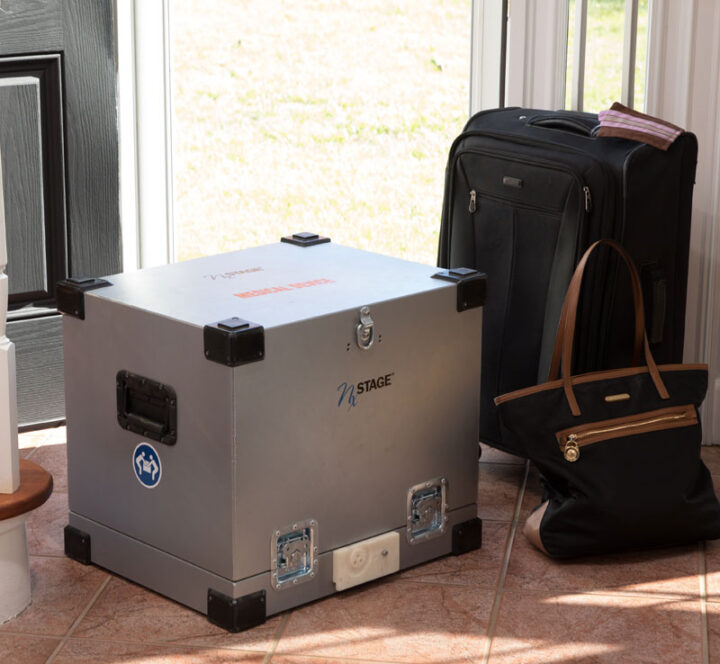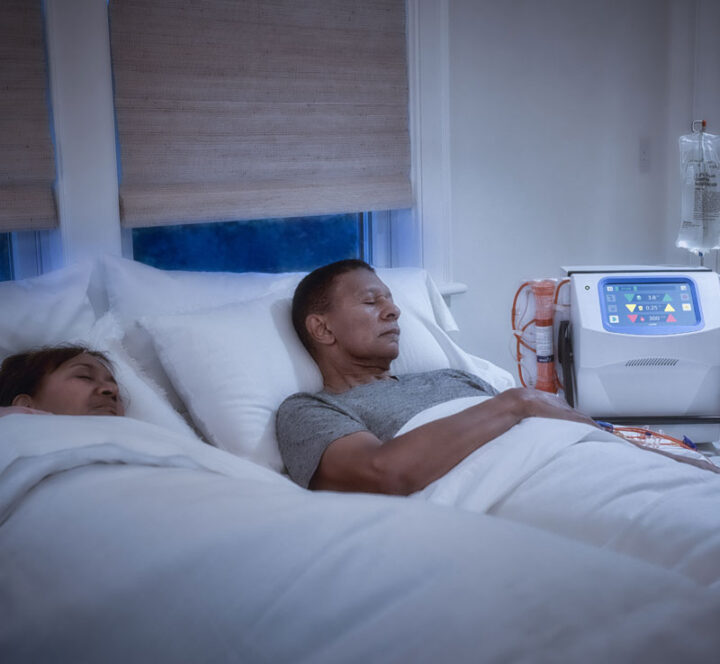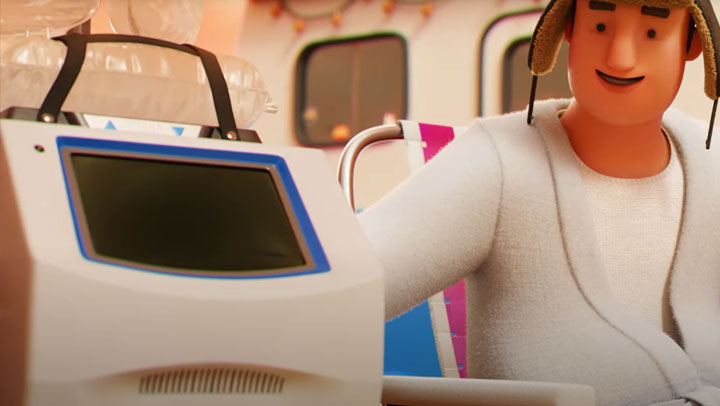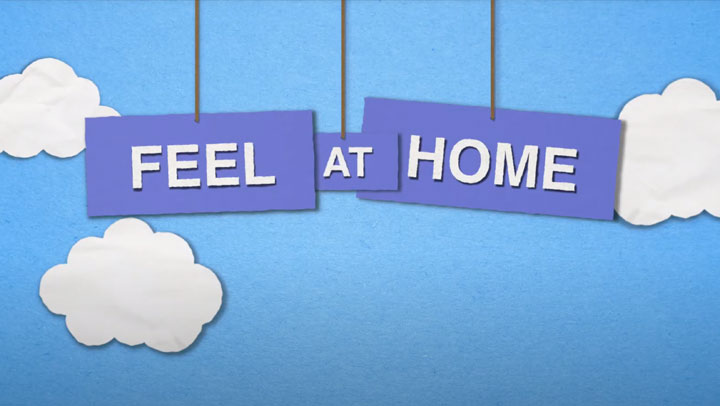When you feel better, you live better. Get your life back. Faster Recovery1, More Energy2, Less Stress on the Heart3.
Designed to be compact, portable, and flexible within the home, NxStage systems allow patients to perform dialysis to fit their health and lifestyle needs. More frequent HHD may lead to a variety of health and quality of life improvements.
- The only system cleared for home nocturnal hemodialysis therapy, allowing for treatment while you and your care partner sleep.
- Fit treatment into your lifestyle with solo home hemodialysis. NxStage systems allow for more flexibility and the option to treat without a care partner during waking hours, with approval from your doctor.
- The compact size allows for transport of the machine. NxStage systems are the only home hemodialysis machines that can travel with you by car or plane on that next special trip.
- NxStage systems are the only home hemodialysis machines weighing less than 85 pounds making them the most portable HHD cyclers during a natural disaster.
- NxStage systems are the only home hemodialysis machines cleared in the US that can use pre-mixed bagged dialysate. This means you do not need to have access to a water source to do your treatments.
- Personalized training, and 24/7 NxStage technical support, ensuring you are comfortable and confident in your treatment routine.
*Not all patients may experience these benefits.
Frequently Asked Questions
-
What is the NxStage System One?
Back to TopBack to TopThe NxStage System One is the only truly portable hemodialysis system cleared for home use available in the United States. It is the smallest and lightest commercially-available hemodialysis system today. Its simplicity and compact size are intended to allow easy use in patients’ homes and give patients the opportunity to travel with their therapy. In addition, 90% of Nephrologists (Renal Physicians) said they would choose home dialysis for themselves.4
-
What makes NxStage different?
Back to TopBack to TopThe System One is small and portable; it weighs roughly 75 pounds and is just over a foot tall. It was designed for home use by patients and care partners and plugs into any standard electrical outlet and requires no special electrical connections. It requires no special plumbing modifications; the dialysate preparation system utilizes a simple faucet, under-sink, or washer connection and drains into any sink, toilet, or drain.
-
What are the benefits associated with more frequent hemodialysis?
Back to TopBack to TopMany patients report - and various studies have confirmed — that more frequent home hemodialysis may offer the following health and quality of life benefits:
- More energy and vitality2
- Quicker recovery after treatment1
- Better sleep5
- Fewer fluid and diet restrictions6
- Ability to keep working or go back to work7
- Longer life expectancy8
- More likely to receive a kidney transplant9
- Better blood pressure control with fewer medications10
- Less stress on the heart3
-
What are the benefits of nocturnal therapy?
Back to TopBack to TopHome nocturnal hemodialysis is an important therapy option associated with a number of lifestyle and clinical advantages. By doing therapy while sleeping, the patient frees up their day to pursue other activities therefore reducing the overall burden of therapy11. A longer, overnight therapy also allows greatly expanded flexibility in dialysis dose and schedule, better enabling physicians to match the dialysis prescription to individual patient needs.
-
How will I be trained?
Back to TopBack to TopYour dialysis center will train you and your care partner on home hemodialysis therapy. During the training, you and your care partner will learn how to access your blood, operate the NxStage system, monitor your vital signs, administer your prescriptions, and handle emergency situations.
Risks and Responsibilities
The reported benefits of home hemodialysis may not be experienced by all patients.
Despite the health benefits that more frequent home hemodialysis may provide to those with chronic kidney disease, this form of therapy is not for everyone. Please review this information carefully and discuss it with your doctor as you evaluate your therapy options.
Personal and Partner Responsibility
Home hemodialysis with NxStage during the day may not require a care partner, provided a physician and a trained and qualified patient agree that solo home hemodialysis is appropriate. Patients performing nocturnal treatments are still required to have a trained care partner. Care partners are trained on and follow system guidelines for proper operation. If you choose to do more frequent home hemodialysis, you will be responsible for complying with your dialysis prescription, which may require treatments up to six days per week. Each treatment can take about 2½ to 3 hours or more including set-up and tear-down.
If you choose to do home hemodialysis alone during the day, you will need to take on the responsibility for tasks that would normally be taken care of by center staff when receiving treatment in-center. You will need to perform all aspects of the dialysis treatment from start to finish, including setting up the dialysis equipment, needle sticks, responding to and resolving all system alarms, and system tear-down at the end of treatment. In addition, you must monitor your blood pressure, ensure that proper aseptic technique is followed, and follow all of the training material and instructions given to you by your training nurses. You will also be trained on and need to know how to respond to any health emergencies that might happen during treatment at home, including dizziness, nausea, hypotension (low blood pressure), and fluid or blood leaks.
Similarly, for patients treating nocturnally, or who wish to have a trained care partner, you and your care partner will both be responsible for understanding and performing the above tasks.
Treatment Environment
To do home hemodialysis successfully, you must take care to ensure that you have a clean and safe environment for your treatments. You will also need to set aside space in your home for the needed supplies.
Risks Associated with All Forms of Hemodialysis
All forms of hemodialysis, including treatments performed in-center and at home, involve some risks. These may include high blood pressure, fluid overload, low blood pressure, heart-related issues, vascular access complications, cramps, backache, headache, dizziness, nausea, an “off” taste in the mouth, fatigue, fever, chills, joint pain, itching, seizures or sinusitis.
All hemodialysis therapies also involve the use of medical devices that introduce the potential for additional risks including air entering the bloodstream, damage of red blood cells, inflammatory reactions, blood chemistry imbalances, blood loss due to clotting of the blood tubing set or accidental blood line disconnection or other leak, allergic reactions, and excess warming or cooling of the dialysate. In addition, dialysis patients may have other underlying diseases that may, in some cases, make it more difficult for them to manage their hemodialysis treatments.
Risks associated with More Frequent Home Hemodialysis
Studies suggest that patients performing more frequent home hemodialysis may experience slightly fewer complications associated with their treatments, and actually may enjoy improved clinical outcomes. However, there are certain risks unique to treatment in the home environment. Treatments at home are done without the presence of medical personnel and on-site technical support. Patients and their care partners, if performing nocturnal treatments, must both be trained on what to do and how to get medical or technical help if needed. When vascular access is exposed to more frequent use, infection of the site, and other access related complications may also be potential risks.
With more frequent home hemodialysis, you are taking on a great deal of responsibility, but many NxStage patients feel that the benefits of this therapy are worth taking on these responsibilities. Thousands of patients are performing more frequent home hemodialysis with the NxStage System One and are enjoying the health benefits, improved quality of life, and additional freedom it can provide.
When performed correctly under the direction and with the support of your medical care team, more frequent home hemodialysis with NxStage may offer tremendous health and quality of life benefits. You should talk to your doctor to better understand the risks involved and how they might apply to you – and to determine if more frequent home hemodialysis is right for you.
Risks Associated with Solo Home Hemodialysis Therapy
A trained and qualified patient may dialyze alone, without a care partner present (solo home hemodialysis), provided the patient and physician agree that solo home hemodialysis is appropriate. Certain risks associated with hemodialysis treatment are increased when performing solo home hemodialysis because no one is present to help the patient respond to health emergencies. If patients experience needles coming out, blood loss, or very low blood pressure during solo home hemodialysis, they may lose consciousness or otherwise become impaired during any health emergency while alone could result in significant injury or death. Additional ancillary devices and training are required when performing solo home hemodialysis. Patients should consult their physician to understand the risks and responsibilities associated with solo home hemodialysis using the NxStage System One.
Increased Risks Associated with Home Nocturnal Hemodialysis Therapy
The NxStage System One may be used at night while the patient and care partner are sleeping. Certain risks associated with hemodialysis treatment are increased when performing nocturnal therapy due to the length of treatment time and because therapy is performed while the patient and care partner are sleeping. These risks include, but are not limited to, blood access disconnects and blood loss during sleep, blood clotting due to slower blood flow or increased treatment time or both, and delayed response to alarms when waking from sleep.
Treatment with nocturnal therapy may require adjustments to medications, including but not limited to iron, Erythropoiesis-Stimulating Agents (ESA), insulin/oral hypoglycemics, anticoagulants, and phosphate binders.
Patients should consult with their physician to understand the risks and responsibilities associated with home nocturnal hemodialysis using the NxStage System One.
References
- Jaber BL, Lee Y, Collins AJ, et al. Effect of daily hemodialysis on depressive symptoms and postdialysis recovery time: interim report from the FREEDOM (Following Rehabilitation, Economics and Everyday-Dialysis Outcome Measurements) Study. Am J Kidney Dis. 2010;56(3):531-539.
- Finkelstein F, Gehr T, Kraus M, et al. Daily hemodialysis (DHD) improves quality of life (QofL): interim results from the FREEDOM study. Abstract presented as poster at Annual Dialysis Conference, 2011.
- Jefferies et.al. Frequent hemodialysis schedules are associated with reduced levels of dialysis-induced cardiac injury (Myocardial stunning). Clin J Am Soc Neprhol. 2011;6(6):1326-1332.
- Merighi JR, Schatell DR, Bragg-Gresham JL, Witten B, Mehrotra R. Insights into nephrologist training, clinical practice, and dialysis choice. Hemodial Int. 2012;16(2):242-251.569.
- Jaber BL, Schiller B, Burkart JM, et al. Impact of short daily hemodialysis on restless legs symptoms and sleep disturbances. Clin J Am Soc Nephrol. 2011;6(5):1049-1056.
- Spanner E, Suri R, Heidenheim AP, Lindsay RM. The impact of quotidian hemodialysis on nutrition. Am J Kidney Dis. 2003;42(1 suppl):30-35.
- Kraus MA, Cox CG, Summitt CL, et al. Work and travel in a large Short Daily Hemodialysis (SDHD) program. Abstract presented at American Society of Nephrology Annual Conference, 2007.
- Weinhandl ED, Lie J, Gilbertson DT, Arneson TJ, Collins AJ. Survival in daily home hemodialysis and matched thrice-weekly in-center hemodialysis patients. J Am Soc Nephrol. 2012;23(5):895-904.
- Weinhandl E, Liu J, Gilbertson D, Arneson T, Collins A. Transplant incidence in frequent hemodialysis and matched thrice-weekly hemodialysis patients. Poster presented at National Kidney Foundation Spring Clinical Meeting, 2012.
- FHN Trial Group. In-center hemodialysis six times per week versus three times per week. N Engl J Med. 2010;363(24):2287-2300.
- Diaz-Buxo JA, Zeller-Knuth CE, Rambaran KA, Himmele R. Home hemodialysis dose: balancing patient needs and preferences. Blood Purif. 2015;39(1-3):45-49. doi: 10.1159/000368944.


